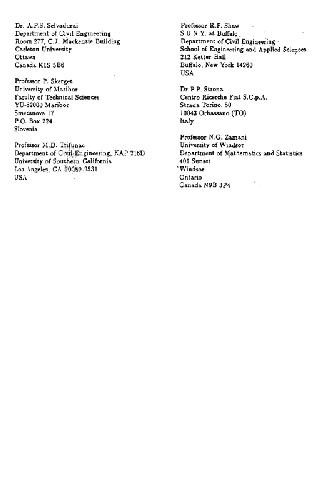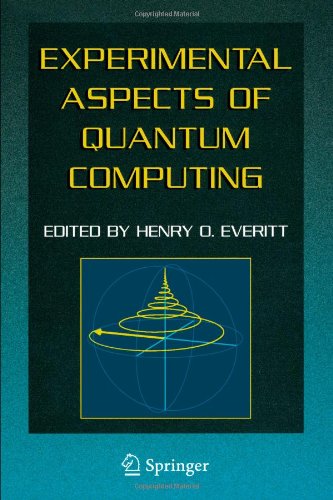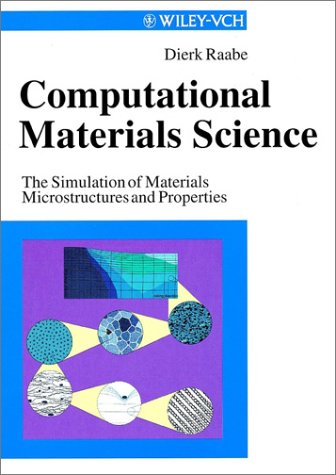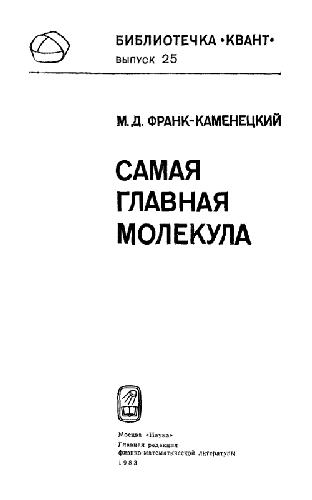Julio A. Gonzalo9812568751, 9789812568755
Table of contents :
Contents……Page 12
Preface……Page 8
Preface to the Second Edition……Page 10
Part 1 Mean Field Approach to Cooperative Phenomena……Page 15
1.1 An overview……Page 17
1.2 Liquid-vapor transitions……Page 25
1.3 Ferromagnetic transitions……Page 35
1.4 Superconductive transitions……Page 45
1.5 Order-disorder transitions in alloys……Page 51
1.6 Ferroelectric transitions……Page 59
1.7 Superfluid transitions……Page 67
1.8 Ferroelastic transitions……Page 75
1.9 Landau theory and effective field approach. Role of fluctuations……Page 81
1.10 Equation of state and the scaling function……Page 95
Appendix: Effective field approach to superconductors……Page 105
Part 2 Some Applications to Ferroelectrics: 1970-1991……Page 115
2.1 Behavior at T = Tc of pure ferroelectric systems with second order phase transition……Page 117
2.2 Effects of dipolar impurities in small amounts……Page 133
2.3 Mixed ferro-antiferroelectric systems and other mixed ferroelectric systems……Page 143
2.3.1 Comment on “Ferroelectricity in zinc cadmium telluride”……Page 151
2.4 Relaxation phenomena near Tc……Page 155
2.5 Polarization reversal in ferroelectric systems……Page 161
2.6 Polarization switching by domain wall motion……Page 169
2.7 Switching current pulse shape……Page 177
2.8 Elementary excitations in ferroelectrics: Dipole waves……Page 183
2.9 Low-temperature behavior of ferroelectrics……Page 193
2.10 Logarithmic corrections……Page 197
Part 3 Some Applications to Ferroelectrics: 1991-1997……Page 203
3.1 Pressure dependence of the free energy expansion coefficients in PbTiO3 and BaTiO3 and tricritical point behavior……Page 205
3.2 Ultrasonic study of the ferroelectric phase transition in RbD2PO4……Page 211
3.3 New technique for investigating ferroelectric phase transitions: The photoacoustic effect……Page 221
3.4 Tricritical point behavior and quadrupole interactions in ferroelectrics……Page 229
3.5 Frequency and temperature dependence of sound velocity in TGS near Tc……Page 235
3.6 Dipolar and higher order interactions in ferroelectric TSCC……Page 243
3.7 Thermal hysteresis and quadrupole interactions in ferroelectric transitions……Page 251
3.8 Specific heat and quadrupole interactions in uniaxial ferroelectrics……Page 257
3.9 Field-dependent temperature shift of the dielectric losses peak in TGS……Page 263
3.10 Discontinuity and quasitricritical behavior near Tc in ferroelectric triglycine selenate……Page 269
3.11 Scaling equation of state for ferroelectric triglycine selenate at T ≈ Tc
……Page 279
3.12 Composition dependence of the ferroelectric-paraelectric transition in the mixed system PbZr1-xTixO3……Page 287
3.13 Observations of two ferroelectric response times in TGSe at T ≤ Tc
……Page 297
3.14 Equation of state for pressure and temperature induced transition in ferroelectric telluric acid ammonium phosphate……Page 303
3.15 Neutron diffraction investigation of the FRL-FRH transition in Nb-doped PbZr1-xTixO3 with x = 0.035……Page 313
3.16 O3 tilt and Pb/(Zr/Ti) displacement order parameters in Zr-Rich PbZr1-xTixO3 from 20 to 500 K……Page 319
3.17 Dielectric characterization of the phase transitions in Pb1-y/2(Zr1-xTix)1-yNbyO3 (0.03 ≤ x ≤ 0.04, 0.025 ≤ y ≤ 0.05)……Page 333
Part 4 Some Applications to Ferrolectrics: 1998-2005……Page 349
4.1 Scaling and metastable behavior in uniaxial ferroelectrics……Page 351
4.2 Energy conversion with Zr-rich lead Zirconate/Titanate ceramics……Page 365
4.3 Microscopic characterization of low-field switching in ferroelectric TGS……Page 371
4.4 Brillouin scattering studies of ferroelectric triglycine selenate sound velocity versus uniaxial pressure at T ~ Tc……Page 381
4.5 Piezoelectric resonance investigation of Zr-rich PZT at room temperature……Page 391
4.6 Transition temperature dependence in perovskite ceramics as a function of grain size……Page 399
4.7 A monoclinic ferroelectric phase in the Pb(Zr1-xTix)O3 solid solution……Page 403
4.8 Tetragonal-to-monoclinic phase transition in ferroelectric perovskite: The structure of PbZr0.52Ti0.48O3……Page 411
4.9 Evolution of the ferroelectric transition character of partially deuterated triglycine selenate……Page 433
4.10 Composition dependence of transition temperature in mixed ferroelectric-ferroelectric systems……Page 441
4.11 Temperature dependence of mode Grüneisen parameters in ferroelectric perovskites at T = Tc……Page 449
4.12 Quantum tunneling versus zero point energy in double-well potential model for ferroelectric phase transitions……Page 453
Index……Page 465







Reviews
There are no reviews yet.